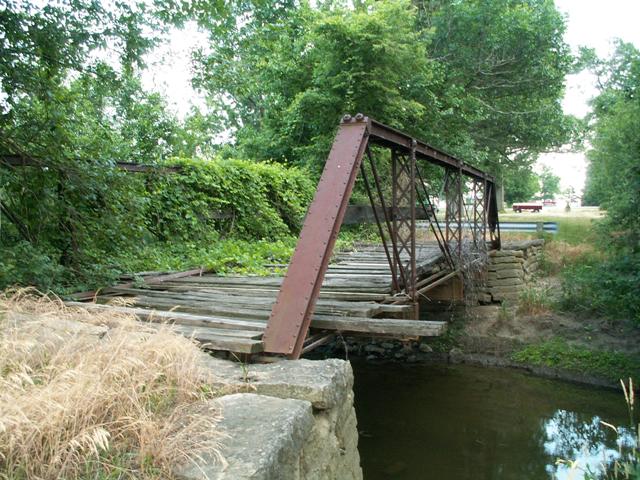We Recommend:
Bach Steel - Experts at historic truss bridge restoration.
BridgeHunter.com Phase 1 is released to the public! - Visit Now
TR-245 Bridge

Primary Photographer(s): Nathan Holth and Rick McOmber
Bridge Documented: June 24, 2007
Rural: Hancock County, Ohio: United States
By Builder/Contractor: Wrought Iron Bridge Company of Canton, Ohio
Not Available or Not Applicable
Not Available
Not Available
Not Available
1 Main Span(s)
Not Applicable

View Information About HSR Ratings
Bridge Documentation
This bridge no longer exists!
This four panel structure was likely built by the Wrought Iron Bridge Company, because it features the unusual bolts at the end posts that act as connections for the bottom chord and diagonal members. In addition, the overall style (latticed vertical members, etc) is similar to other bridges that are officially documented with the company.
This bridge is abandoned, but the trusses in fair condition. The historic bridge inventory is somewhat amusing because it makes it sound like the bridge is a train wreck. It mostly looked like whatever impacted the bridge (perhaps farm equipment) mainly just ripped the end post cover plate apart. The other parts of the bridge are certainly feasible to rehabilitate, and the cover plate could be replaced in kind. The bridge would be an outstanding candidate for relocation and reuse on a pedestrian trail or in a park somewhere. However, there may be a time limit to this opportunity, since the stone abutments the bridge sits on are cracked and the bridge may in the future become at risk for collapse. It would be shame to lose a bridge that is so small and thus easy to relocate and preserve.
This bridge is similar to the nearby 251 bridge.
Information and Findings From Ohio's Historic Bridge InventorySetting/Context The bridge is abandoned and closed to traffic. It is in a rural setting of active agriculture. Physical Description The 1 span, pin-connected Pratt pony truss bridge has built-up compression members and eyebar or rod tension members. The upper chords are toe-out channels with cover plates and battens. The verticals are angles with lacing. The diagonal rods connections at the upper chord connection in the end panels is bolted through a cast-iron connecting piece, a detail associated with the Wrought Iron Bridge Co. The floorbeams are suspended from the lower chord pins by U-shaped hangers. The wood deck is partially missing. The bridge is supported on stone abutments. Integrity The bridge has significant impact damage that has opened/twisted the end posts on the south side. Cover plates are missing and or holed through. The ashlar abutments are cracked and failing. Summary of Significance The ca. 1880 pin-connected Pratt pony truss bridge has lost integrity of design due to impact damage and metal-related deterioration. It is 1 of at least 13 examples of pony trusses by this builder and of similar
date/design in the ODOT inventory (July 2009). The more complete examples better represent the technological significance of the type/design. Bridge Considered Historic By Survey: No |
![]()
Photo Galleries and Videos: TR-245 Bridge
Bridge Photo-Documentation
A collection of overview and detail photos. This photo gallery contains a combination of Original Size photos and Mobile Optimized photos in a touch-friendly popup viewer.Alternatively, Browse Without Using Viewer
![]()
Maps and Links: TR-245 Bridge
This historic bridge has been demolished. This map is shown for reference purposes only.
Coordinates (Latitude, Longitude):
Search For Additional Bridge Listings:
Bridgehunter.com: View listed bridges within 0.5 miles (0.8 kilometers) of this bridge.
Bridgehunter.com: View listed bridges within 10 miles (16 kilometers) of this bridge.
Additional Maps:
Google Streetview (If Available)
GeoHack (Additional Links and Coordinates)
Apple Maps (Via DuckDuckGo Search)
Apple Maps (Apple devices only)
Android: Open Location In Your Map or GPS App
Flickr Gallery (Find Nearby Photos)
Wikimedia Commons (Find Nearby Photos)
Directions Via Sygic For Android
Directions Via Sygic For iOS and Android Dolphin Browser
USGS National Map (United States Only)
Historical USGS Topo Maps (United States Only)
Historic Aerials (United States Only)
CalTopo Maps (United States Only)

